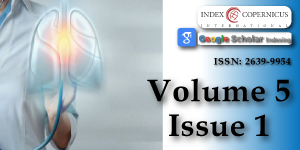Chronic fatigue syndrome and epigenetics: The case for hyperbaric oxygen therapy in biomarker identification
Main Article Content
Abstract
Chronic fatigue syndrome (CFS) is a poorly-understood respiratory condition that affects millions of individuals. Hyperbaric oxygen therapy (HBOT) is a treatment option being considered to address CFS as it is suggested to combat fatigue and increase oxygenation. HBOT provides two opportunities in advancing research of CFS: it may provide data on symptom amelioration and be utilized in the search for a biomarker. By either identifying biomarkers before using HBOT to compare epigenomes of patients before and after treatment or using HBOT to find epigenetic discrepancies between patients with and without treatment, matching epigenetic regulation with symptom amelioration may significantly advance the understanding of the etiology and treatment mechanism for CFS. EPAS1/HIF-2α is a leading candidate for an epigenetic biomarker as it responds differentially to hypoxic and normoxic conditions, which degrades more slowly in hypoxic conditions. Epigenetic regulation of EPAS1/HIF-2α in such differential conditions may be explored in HBOT experiments. In addition to HBOT as a promising treatment option for CFS symptoms, it may aid the identification of biomarkers in CFS. Further research into both outcomes is strongly encouraged.
Article Details
Copyright (c) 2021 Shah RJ.

This work is licensed under a Creative Commons Attribution 4.0 International License.
Broderick G, Fuite J, Kreitz A, Vernon SD, Klimas N, et al. A formal analysis of cytokine networks in chronic fatigue syndrome. Brain Behav Immun. 2010; 24: 1209-1217. PubMed: https://pubmed.ncbi.nlm.nih.gov/20447453/
Landmark-Høyvik H, Reinertsen KV, Loge JH, Kristensen VN, Dumeaux V, et al. The genetics and epigenetics of fatigue. PMR. 2010; 2: 456-465. PubMed: https://pubmed.ncbi.nlm.nih.gov/20656628/
Friedberg F, Jason LA. Understanding chronic fatigue syndrome: An empirical guide to assessment and treatment. American Psychological Association. 1998.
Lombardi VC, Ruscetti FW, Gupta JD, Pfost MA, Hagen KS, et al. Detection of an infectious retrovirus, XMRV, in blood cells of patients with chronic fatigue syndrome. Science. 2009; 326: 585-589. PubMed: https://pubmed.ncbi.nlm.nih.gov/19815723/
Jason LA, Porter N, Brown M, Anderson V, Brown A, et al. CFS: a review of epidemiology and natural history studies. Bull IACFS ME. 2009; 17: 88-106. PubMed: https://pubmed.ncbi.nlm.nih.gov/21243091/
Mayo Clinic. Hyperbaric oxygen therapy. https://www.mayoclinic.org/tests-procedures/hyperbaric-oxygen-therapy/about/pac-20394380
Sleiman SF, Henry J, Al-Haddad R, El Hayek L, Abou Haidar E, et al. Exercise promotes the expression of brain derived neurotrophic factor (BDNF) through the action of the ketone body β-hydroxybutyrate. Elife. 2016; 5: e15092. PubMed: https://pubmed.ncbi.nlm.nih.gov/27253067/
Goldman B. Some headway on chronic fatigue syndrome: Brain abnormalities pinpointed. 2014. http://scopeblog.stanford.edu/2014/10/29/some-headway-on-chronic-fatigue-syndrome-brain-abnormalities-pinpointed/.
Ding R, Jin Y, Liu X, Zhu Z, Zhang Y, et al. H3K9 acetylation change patterns in rats after exposure to traffic-related air pollution. Environ Toxicol Pharmacol. 2016; 42: 170-175. PubMed: https://pubmed.ncbi.nlm.nih.gov/26855416/
John’s Hopkins Medicine. Hyperbaric Oxygen Therapy for Wound Healing. http://www.hopkinsmedicine.org/healthlibrary/test_procedures/neurological/hyperbaric_oxygen_therapy_for_wound_healing_135,44/
Akarsu S, Tekin L, Ay H, Carli AB, Tok F, et al. The efficacy of hyperbaric oxygen therapy in the management of chronic fatigue syndrome. Undersea Hyperb Med. 2013; 40: 197-200. PubMed: https://pubmed.ncbi.nlm.nih.gov/23682549/
Hoof EV, Coomans D, Becker PD, Meeusen R, Cluydts R, et al. Hyperbaric therapy in chronic fatigue syndrome. J Chronic Fatigue Syndr. 2003; 11: 37-49.
MedlinePlus. EPAS1 Gene. https://ghr.nlm.nih.gov/gene/EPAS1#conditions
Henderson J, Withford-Cave JM, Duffy DL, Cole SJ, Sawyer NA, et al. The EPAS1 gene influences the aerobic–anaerobic contribution in elite endurance athletes. Hum Genet. 2005; 118: 416-423. PubMed: https://pubmed.ncbi.nlm.nih.gov/16208515/
Beall CM, Cavalleri GL, Deng L, Elston RC, Gao Y, et al. Natural selection on EPAS1 (HIF2α) associated with low hemoglobin concentration in Tibetan highlanders. Proc Natl Acad Sci U S A. 2010; 107: 11459-11464. PubMed: https://pubmed.ncbi.nlm.nih.gov/20534544/
Graham AM, McCracken KG. Convergent evolution on the hypoxia-inducible factor (HIF) pathway genes EGLN1 and EPAS1 in high-altitude ducks. Heredity. 2019; 122: 819-832. PubMed: https://pubmed.ncbi.nlm.nih.gov/30631144/
Wenger RH, Stiehl DP, Camenisch G. Integration of oxygen signaling at the consensus HRE. Sci STKE. 2005; 2005: re12. PubMed: https://pubmed.ncbi.nlm.nih.gov/16234508/
Storti F, Santambrogio S, Crowther LM, Otto T, Abreu-Rodríguez I, et al. A novel distal upstream hypoxia response element regulating oxygen-dependent erythropoietin gene expression. Haematologica. 2014; 99: e45-48. PubMed: https://pubmed.ncbi.nlm.nih.gov/24510339/
Lorenzo FR, Yang C, Fui MN, Vankayalapati H, Zhuang Z, et al. A novel EPAS1/HIF2A germline mutation in a congenital polycythemia with paraganglioma. J Mol Med. 2013; 91: 507-512. PubMed: https://pubmed.ncbi.nlm.nih.gov/23090011/
Haase VH. Regulation of erythropoiesis by hypoxia-inducible factors. Blood Rev. 2013; 27: 41-53. https://pubmed.ncbi.nlm.nih.gov/23291219/
Liu S, McConnell SC, Ryan TM. Erythropoiesis in the absence of adult hemoglobin. Mol Cell Biol. 2013; 33: 2241-2251. PubMed: https://pubmed.ncbi.nlm.nih.gov/23530053/
Comino-Méndez I, de Cubas AA, Bernal C, Álvarez-Escolá C, Sanchez-Malo C, et al. Tumoral EPAS1 (HIF2A) mutations explain sporadic pheochromocytoma and paraganglioma in the absence of erythrocytosis. Hum Mol Genet. 2013; 22: 2169-2176. PubMed: https://pubmed.ncbi.nlm.nih.gov/23418310/
Streeten DH, BellMD DS. Circulating blood volume in chronic fatigue syndrome. J Chronic Fatigue Syndrome. 1998; 4: 3-11.

